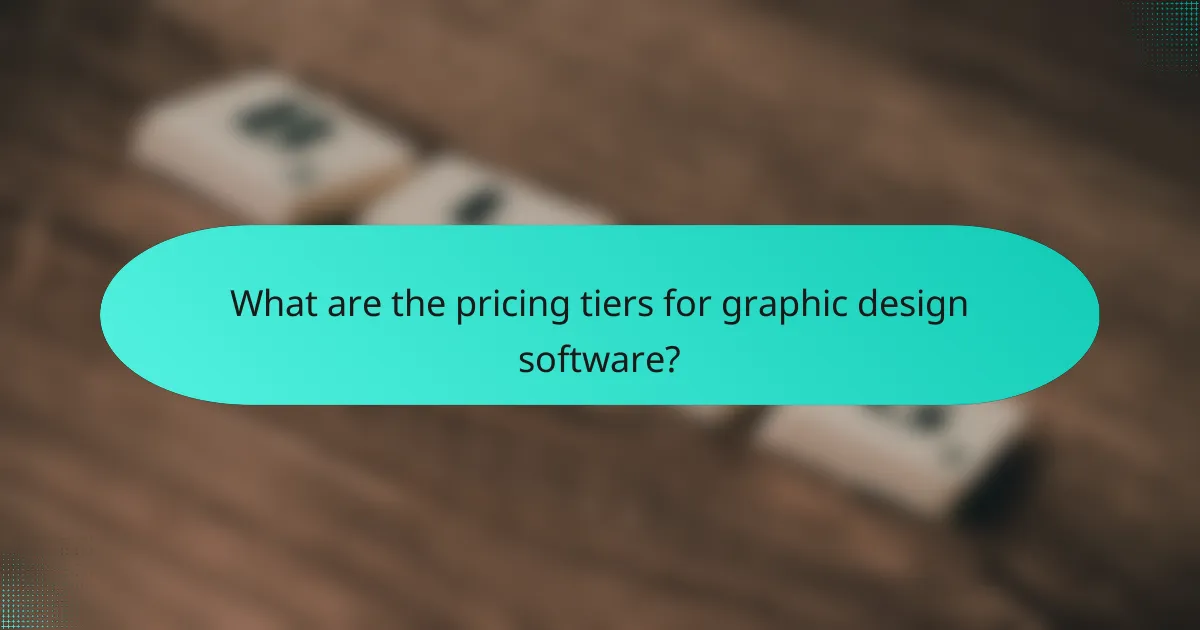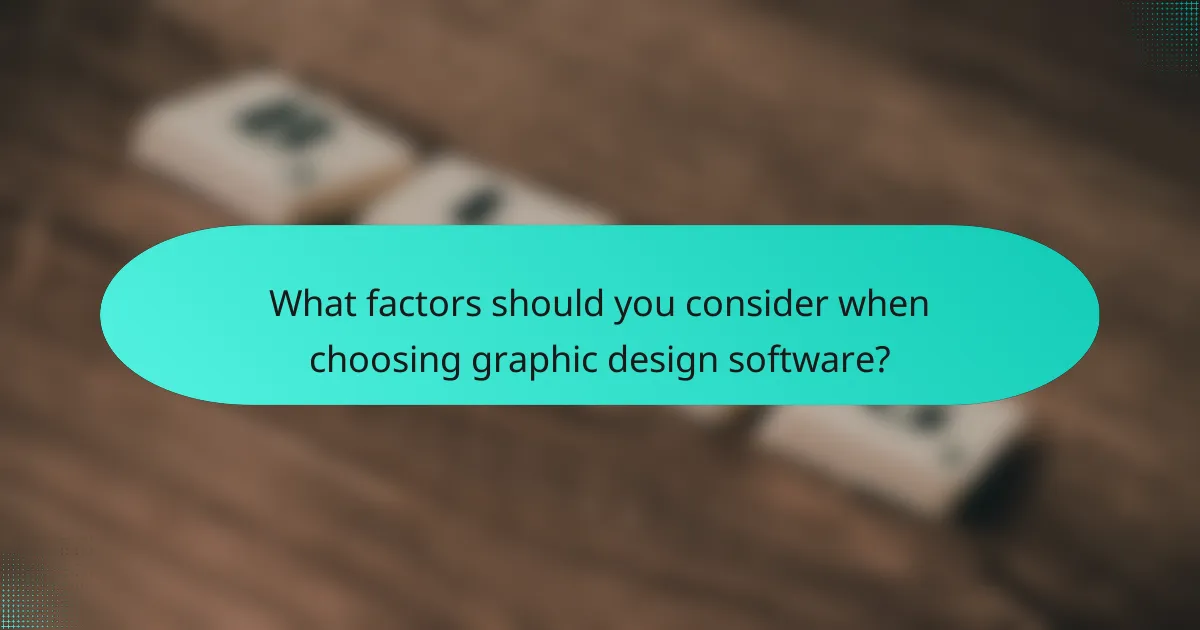Choosing the right graphic design software involves considering usability, template availability, and pricing tiers. Intuitive interfaces, like those found in Adobe Creative Cloud and Canva, enhance the experience for both beginners and professionals. Additionally, understanding the range of pricing options can help you select software that fits your budget while meeting your design needs.

Which graphic design software offers the best usability in Canada?
In Canada, usability in graphic design software is crucial for both beginners and professionals. Programs like Adobe Creative Cloud and Canva stand out for their intuitive interfaces and extensive resources, making them popular choices among users.
Adobe Creative Cloud
Adobe Creative Cloud is a comprehensive suite that includes industry-standard tools like Photoshop, Illustrator, and InDesign. Its usability is enhanced by a wealth of tutorials and community support, making it suitable for both novices and experienced designers.
However, the learning curve can be steep for new users. Consider starting with Adobe’s free trial to explore its features before committing to a subscription, which typically ranges from CAD 20 to CAD 80 per month depending on the plan.
Canva
Canva is known for its user-friendly interface, making it ideal for quick design tasks. With a drag-and-drop functionality and a vast library of templates, users can create professional-looking graphics without extensive design experience.
Canva offers a free version, but the Pro subscription, priced around CAD 15 per month, unlocks additional features like premium templates and advanced collaboration tools. This makes it a cost-effective option for small businesses and individuals.
CorelDRAW
CorelDRAW is a powerful graphic design software that excels in vector illustration and layout design. Its usability is enhanced by customizable workspaces and a variety of tools tailored for different design needs.
While it offers a one-time purchase option, which can be around CAD 500, users should weigh this against subscription models from competitors. A free trial is available, allowing potential users to assess its fit for their workflow.
Affinity Designer
Affinity Designer is a cost-effective alternative to Adobe products, offering robust vector and raster design capabilities. Its interface is streamlined, making it accessible for users transitioning from simpler software.
Priced at approximately CAD 70 for a one-time purchase, it provides excellent value without ongoing subscription fees. Users should take advantage of the trial version to see if it meets their design needs.
Sketch
Sketch is a vector-based design tool primarily used for web and mobile UI/UX design. Its usability is enhanced by features like symbols and shared styles, which streamline the design process for teams.
Available only on macOS, Sketch operates on a subscription model costing around CAD 10 per month. This makes it a popular choice among designers focused on digital products, but potential users should consider its platform limitations before committing.

What are the pricing tiers for graphic design software?
Graphic design software typically offers various pricing tiers to accommodate different user needs, ranging from free basic versions to premium subscriptions. Understanding these tiers can help you choose the right software based on your budget and required features.
Adobe Creative Cloud pricing
Adobe Creative Cloud offers several subscription plans, including individual apps and all-apps bundles. Monthly fees generally range from around $20 to $80, depending on whether you choose a single app or the complete suite.
Students and educators can often access significant discounts, making it more affordable for those in academic settings. Keep an eye out for promotional offers that may further reduce costs.
Canva subscription options
Canva provides a free version with basic features, while its Pro subscription costs approximately $12.99 per month when billed annually. The Pro plan includes advanced tools, additional templates, and the ability to collaborate with team members.
For larger organizations, Canva offers an Enterprise plan with custom pricing that includes enhanced brand management features and dedicated support. This tier is ideal for businesses needing extensive design capabilities.
CorelDRAW pricing plans
CorelDRAW offers a subscription model starting at around $20 per month, or a one-time purchase option priced at about $499. The subscription includes updates and access to additional resources, while the one-time purchase provides a perpetual license.
Consider your long-term needs when choosing between these options, as the subscription may be more cost-effective if you require regular updates and new features.
Affinity Designer one-time purchase
Affinity Designer is available for a one-time purchase price of about $54.99, making it a budget-friendly option for those who prefer not to commit to ongoing subscriptions. This pricing model allows users to access all features without additional fees.
Affinity also offers discounts for educational users, which can make it an attractive choice for students and teachers looking for professional design software at a lower cost.
Sketch pricing model
Sketch operates on a subscription basis, costing approximately $99 per year per user. This model includes access to updates and cloud features, which are essential for collaboration among design teams.
For teams, Sketch offers a shared licensing option that can reduce costs per user when multiple licenses are purchased. Evaluate your team’s size and needs to determine the most economical approach.

How does template availability vary across graphic design software?
Template availability in graphic design software can significantly influence user experience and project efficiency. Different platforms offer varying quantities and types of templates, catering to diverse design needs and skill levels.
Canva template library
Canva boasts a vast library of templates, with thousands of options spanning categories like social media, presentations, and marketing materials. Users can easily customize these templates, making it accessible for both beginners and experienced designers.
Templates in Canva are organized by theme and purpose, allowing users to quickly find what they need. The free version provides a substantial selection, while the Pro subscription unlocks additional premium templates and features.
Adobe Creative Cloud templates
Adobe Creative Cloud offers templates primarily through its individual applications, such as Photoshop, Illustrator, and InDesign. Users can access a range of templates tailored for specific projects, but the selection may not be as extensive as Canva’s.
While many templates are available for free, Adobe also provides premium options through Adobe Stock. This can add to the overall cost, so users should weigh the benefits of high-quality templates against their budget.
CorelDRAW templates
CorelDRAW features a variety of templates designed for graphic design, print, and web projects. Users can find templates for brochures, business cards, and more, which can be customized to fit specific branding needs.
Corel’s template library is beneficial for users looking for professional-grade designs, but it may require a learning curve for those unfamiliar with the software. Users should explore the templates available in the CorelDRAW community for additional resources.
Affinity Designer templates
Affinity Designer provides a selection of templates, though the library is smaller compared to competitors like Canva. Users can find templates for web design, UI/UX projects, and illustrations, which can be modified to suit individual projects.
While Affinity’s templates are generally high quality, users may need to create their own templates or source them from third-party sites. This can be a consideration for those looking for a wide variety of ready-made options.
Sketch template resources
Sketch offers a range of templates primarily focused on UI/UX design. Users can access templates for mobile apps, websites, and other digital products, which are particularly useful for designers working in tech.
While Sketch has a dedicated community that shares templates, the availability may not be as extensive as other platforms. Users should consider exploring third-party resources or creating their own templates to enhance their design workflow.

What factors should you consider when choosing graphic design software?
When selecting graphic design software, consider usability, template availability, pricing tiers, and compatibility with other tools. These factors will significantly influence your design process and overall satisfaction with the software.
Usability and learning curve
Usability is crucial for effective graphic design software. Look for intuitive interfaces that allow you to navigate easily and access features without extensive training. A shorter learning curve can save you time and enhance productivity.
Many programs offer trial versions, enabling you to test usability before committing. Consider user reviews and tutorials to gauge how quickly you can become proficient with the software.
Template variety and quality
The availability of templates can greatly enhance your design workflow. High-quality templates save time and provide inspiration, especially for beginners. Check if the software offers a diverse range of templates suitable for various projects, such as social media graphics, presentations, and marketing materials.
Evaluate the quality of templates by looking for customizable options that allow you to maintain brand consistency. Some platforms may also provide access to user-generated templates, which can further expand your choices.
Pricing and budget
Pricing structures vary widely among graphic design software, typically ranging from free versions to subscription models costing tens to hundreds of dollars per month. Assess your budget and determine if you prefer a one-time purchase or a subscription that includes regular updates and support.
Be aware of hidden costs, such as fees for additional features or premium templates. Many software options offer tiered pricing, allowing you to choose a plan that fits your needs and financial constraints.
Compatibility with other tools
Compatibility with other tools is essential for a seamless design process. Ensure the software integrates well with applications you already use, such as photo editing software, project management tools, or cloud storage services. This can streamline your workflow and enhance collaboration.
Check for file format support as well, ensuring you can easily import and export designs without losing quality. Compatibility can also affect how you share your work with clients or team members, so prioritize software that meets these needs.

What are the emerging trends in graphic design software?
Emerging trends in graphic design software focus on enhanced usability, diverse template availability, and flexible pricing tiers. These developments aim to streamline workflows, cater to varying user needs, and accommodate different budgets.
Usability
Usability in graphic design software has become a priority, with many tools emphasizing intuitive interfaces and user-friendly features. Programs are increasingly designed to minimize the learning curve, allowing both beginners and experienced designers to create efficiently.
Key usability features include drag-and-drop functionality, customizable workspaces, and real-time collaboration options. Tools like Canva and Adobe Express exemplify this trend by offering straightforward navigation and accessible design elements.
Template Availability
Template availability is a significant factor in graphic design software, as it allows users to start projects quickly and creatively. Many platforms now offer extensive libraries of templates tailored for various industries, including marketing, social media, and print design.
For instance, platforms like Figma and Snappa provide thousands of pre-designed templates, which can be easily customized. This feature saves time and inspires creativity, making it easier for users to produce professional-quality designs without starting from scratch.
Pricing Tiers
Pricing tiers in graphic design software have evolved to accommodate a broader range of users, from hobbyists to professionals. Many tools now offer free versions with basic functionalities, while premium subscriptions unlock advanced features and resources.
For example, Adobe Creative Cloud provides various pricing options, allowing users to choose plans based on their specific needs and budget. This flexibility enables users to select software that aligns with their financial constraints while still accessing powerful design capabilities.
